U.S. Department of Transportation
Federal Highway Administration
1200 New Jersey Avenue, SE
Washington, DC 20590
202-366-4000
| < Previous | Table of Content | Next > |
That suburban activities require the use of a car and generate large amounts of traffic is well known. The overwhelming majority of suburban areas in the United States are oriented only to automobile travel. Most suburbs do not accommodate bicyclists and pedestrians, and they rarely provide good access to transit (with a few exceptions). With all this in mind, however, it is necessary to expand walking and bicycling travel opportunities in the suburbs without eliminating the car. Suburbs were organized around automobile travel and, in many instances, won't function well without it.
This session explores methods of redesigning suburban communities to better accommodate non-motorized transportation. It discusses how the suburbs developed, the hierarchy of the street system, and appropriate modifications that can accommodate and encourage bicycling and walking. This session is mostly oriented toward suburban planning considerations – with reference to other sections that focus on design issues such as traffic calming and walkway/bikeway design.
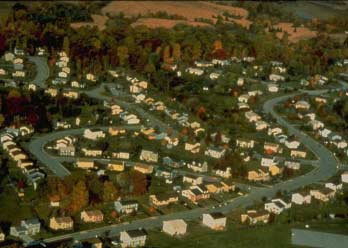
Before the automobile became a part of most American households, many people who now live in suburbs were city dwellers who relied on walking for their transportation close to home and on streetcars, trolleys, or trains for longer trips. The streetcar and railroad lines generally ran from cities to outlying neighborhoods where houses and businesses clustered near major stops. People usually walked from their homes to public transportation, much as they walked from home to the business district to do their shopping.
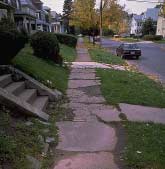 Inadequate maintenance of sidewalks makes a short walk difficult to maneuver. |
Once more and more people were able to afford their own cars, dependence on streetcars, trolleys, and trains diminished as did the need to live near them. Since land farther away from the city was less expensive, people from city neighborhoods began to see the fulfillment of their dream of owning a detached home with land around it. When developers of these homes learned that people would be willing to drive a little farther to buy even less expensive land, leap-frogging began. Leap-frogging is the practice of developing less expensive land farther from the city while leaving vacant more expensive land closer to the city. Developers of schools, businesses, and parks also sought the least expensive land. Thus, the result was scattered facilities and communities with no central focus. Because suburban building became so scattered, streetcar and rail transit were inappropriate, ending usually at the city's edge, and the car became the main means of transportation for suburban residents.
That suburban activities require the use of a car and generate a large amount of traffic is well known. In suburban commercial areas, heavy traffic starts early in the morning and lasts for the entire day until the end of evening rush hour. Traffic is heavy because of the many trips from store to store made by shoppers who find driving between stores easier than walking or bicycling, even though distances may be short enough for these activities. Because of the active, internally generated traffic, walking and bicycling are not safe, or pleasurable, or convenient. Consequently, before viable pedestrian improvements can be made, allday peak traffic must be corrected.
Major pedestrian improvements will come as land-use changes reduce the distances between daily activities. These land-use changes include increasing density and mixing land use, two actions residents of suburbs often believe are inappropriate for suburban lifestyles. That point may soon be moot, as increased density and mixed uses in suburbs are on the upswing. Now, apartments and commercial developments are being built along arterials and on land by-passed by leap-frogging. The pattern of development in many suburbs is infilling. This present pattern is now providing more opportunities for infill development to be designed to accommodate pedestrians and bicyclists as well as to take advantage of bus transportation. While converting to accommodate pedestrians and bicyclists is more difficult than downtown, low-density development does allow improvements not possible in built-up neighborhoods.
Three typical pedestrian problems - safety, function, and pleasure - need to be addressed. Safety problems are real or perceived conflicts as people cross streets or walk where there are no sidewalks. Since suburban drivers cover longer distances and drive faster, the dangers are magnified. The absence of pedestrians on suburban streets dulls drivers' awareness and further aggravates the problem of safety.
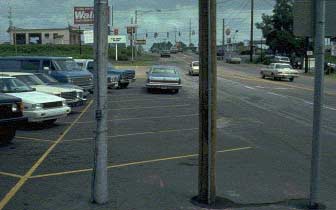 Lack of sidewalks and parked cars along the road's edge create unsafe conditions for bicyclists and pedestrians. |
Functional pedestrian problems are found wherever there is little or no walking space, lack of sidewalks, parked cars along the road's edge, wide driveways, few benches, and barriers. Beyond this, another functional problem is the lack of destinations within a reasonable walking distance. Problems that create unpleasant environments for pedestrians and bicyclist are: walking next to noisy, fast moving cars; poor vistas; few rest stops; streetscapes with little interest to someone who is not driving; vacant lots or large parking lots that are visually dull and potentially unsafe.
Abandoning the Street
The long driving distances necessary to serve low-density areas increase the
speed and volume of suburban traffic, making streets busy and uncomfortable
places. To counter this, an "inside-out" development pattern-the opposite
of the prevalent urban development patterns-has evolved. While most urban communities
focus on and utilize the street suburban communities turn their backs to the
street, and focus human activities on internal gardens, courtyards, and open
spaces. Typically, car parking separates front doors from the sidewalk, and
makes using the car seem most natural. Unfortunately, the interior spaces are
seldom interconnected, so walking or bicycling for long distances in them is
not possible.
The shift was from the urban grid pattern to a suburban road "hierarchy." The grid typical for many cities allows free choice of routes, but doesn't necessarily distinguish between high or low volumes of traffic or between streets that are or aren't good to raise families on. The hierarchy changed that, with its system of roads from arterials carrying high traffic volumes to cul-de-sacs with virtually no vehicular traffic. The secret lies in not interconnecting streets, which positively directed through traffic to arterials. Cul-de-sacs soon became the favored street to live on.
Grid patterns developed when travel by foot was important. As the grid was infinitely divisible, it created a fine-grain network that benefited foot traffic. The hierarchy developed to accommodate the automobile, recognizing that cars can easily travel extra distances, and that as traffic disperses, certain roads should carry more or less traffic than others. Pedestrians, unfortunately, cannot easily travel longer distances, and are the losers.
The hierarchy, in its conceptual form, includes a separate pedestrian system "internal" to the road system that purportedly ensures pedestrian access to different parts of the community. Unfortunately, the internal system was not provided in most cases, and when it was, it didn't lead to the places people wanted to reach because they were located on the roads. Internal circulation spaces were often unsafe because there was so little foot traffic and the varied ownership made access dependent on private property rights. A strategy of: (1) linking internal spaces where possible and (2) making the street usable for pedestrians and bicyclists will enhance suburban living for many people.
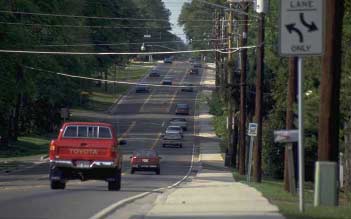
Sidewalks with a landscape strip should be installed to minimize exposure
to vehicular traffic.
To begin, the planner should determine where people want or need to travel; the routes they might travel; and who these people (the users of improved facilities) are. The most likely users of improved sidewalks and bicycle routes are:
Eventually, entire suburban communities should be accessible, safe, and comfortable for all pedestrians and bicyclists. While that will take time and will require changes in land use, it is possible to prioritize improvements to be made in the foreseeable future. These improvements might include the following:
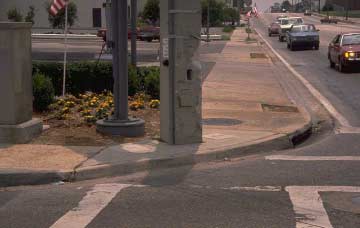
Utilities and the lack of curb cuts makes this intersection very unsafe,
limits the mobility of pedestrians, and does not allow for handicapped
access.
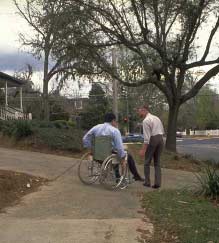 The landscape island acts as a barrier for pedestrian access. |
Suburban land uses affecting pedestrians can be divided into three categories. First, there are individual tract subdivisions, planned as units, with a sense of order derived from the in-road systems. Access is limited to one or two points. Most are single-family residential, though some warehousing, shopping, and medical developments exhibit the same characteristics. The distinguishing characteristics are that each subdivision is a recognizable unit, planned as a whole, and can be re-planned to better serve the pedestrian.
The second type of land use is the linear arterial, which unites the community through cars. While the roadway portion of arterials most likely was engineered, land-use planning was never done for the apartments, warehouses, offices, and businesses that line arterials. However, arterials with these activities form the backbone of most suburban communities, serving both long-distance driving and local business transactions. Arterial strips often convey a sense of the community's image or identity. While this image is presently seldom distinguishing or pleasant, it could be improved with pedestrian-/ bicycle-related amenities.
Arterials are obvious locations for bicycle and pedestrian improvements since these roads pass most community facilities and are the only direct and relatively long through roads in the suburban community. However, most arterials have pedestrian safety and environmental problems that must be overcome. If these problems are too great, it may be possible to improve a route parallel to the arterial, but one block removed.
The third general type of suburban land use is by-passed land, forgotten during initial development as entrepreneurs leap-frogged out to find cheaper land. These lands infill more slowly and more haphazardly than planned subdivisions, and are likely to have many owners and a variety of land uses, though perhaps not as many as along arterials. By-passed lands may be the easiest to adapt to pedestrians and bicycle-related improvements, as they have the highest densities, have mixed land uses, and are close to a variety of services.
The most dangerous places for pedestrians are along suburban roads without sidewalks and intersection treatment. These roads are usually arterials located near schools, bus stops, businesses, or parks. Intersections of residential streets and arterials that have no sidewalks or signals also contribute to risk. Moreover, bus stops have often been located where there are no sidewalks, contributing further to pedestrian hazards.
Develop safe route maps to improve school access safety. As noted, the majority of pedestrian accidents occur to young people, many of them traveling to and from school. To reduce accidents, develop a school trip map, combining the expertise and resources of the police, engineering and school departments, and local parents. The safe route maps should be developed by walking each access street to identify the safest walking routes and dangerous intersections. The program should develop and distribute handout maps, correct dangerous situations, and continue an ongoing evaluation of the selected routes.
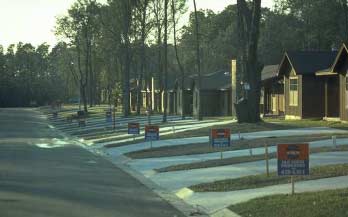
This developer never considered the benefits of pedestrian access.
It is necessary to extend walking and bicycling potential in the suburbs without eliminating the car. Suburbs were organized around automobile travel and, in many instances, won't function well without it. Yet, the car needn't always be dominant and uncontrolled. Increased car usage has constrained its own flexibility because roads have become more crowded and fuel costs have risen. Extending pedestrian and bicycle access within a community may eliminate some need for the car, allowing increased flexibility for those who have to drive. Walkways should be planned for physical and psychological safety from the auto, yet allow direct and easy access to all types of activities. Most walkways should be planned in conjunction with roads, so pedestrians can reach all developments that are located along the road.
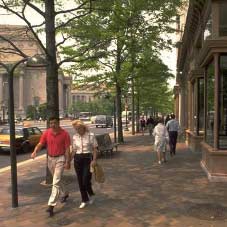
Main building entrances should be oriented on the façade
facing a transit street.
Because there are so many safety problems related to pedestrians in the suburbs, improvements to make bicycling safe may, on balance, prove to be a better initial investment than improvements for pedestrians. Bicycles can travel 5 to 6 miles with relative ease, serving kids going to school, commuter trips, and many shopping activities. Initial bicycle improvements are inexpensive if striping, shoulder widening, and curb cuts are done. Striping and lane alteration could provide space for bicyclists on existing roads, giving them the same access as motorists, and might cost only 5,000 to 10,000 dollars per mile.
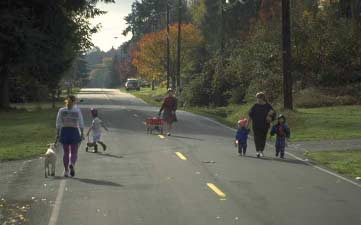 Without sidewalks pedestrians are left to wander in the middle of the street. |
Conceptual planning is relatively simple. It consists of determining the general direction that walkways should take. These satisfy conditions discussed earlier, focusing on shops, schools, cultural attractions, and work and play places. Designing the exact route is the complex part. While many people might articulate the desirability of pedestrian routes, few will agree to have their street changed, to reduce parking, or to pay for a widened pedestrian area. Design, then, should be based first on routes that exist, before establishing new ones. Privacy, views, access, and local character must be understood and incorporated in the design.
Suburban areas typically consist of many small residential developments, each abutting a major road. These major roads lead to services such as shopping, schools, and parks. Pedestrian and bicycle safety problems usually do not exist inside individual suburban developments (unless they are large), but they increase on the major roads. The first consideration is: Should these major arterial streets be organized and developed for non-otorized traffic or do they have insurmountable auto-related problems that suggest finding an alternative route?
Origin/Destination information is necessary in the suburbs not so much because of the crush of users, but to see where users come from and where they go. Simple pedestrian and bicycle volume counts seldom yield enough information about where people are going or come from, the reason for the trip, and any special pedestrian and bicycle needs that should be met. This kind of data may be best obtained through observation of an origin/destination survey that should include the following information:
Since destination points were scattered and sidewalks were expensive to construct, early suburban communities had no sidewalks. Later, some communities required developers to install sidewalks. In most suburbs, there is a patchwork of sidewalks that stop and start, but often aren't linked. In some developments where sidewalks were required, developers constructed them adjacent to the curb, which virtually enlarges the roadway, and places pedestrians next to traffic or parked cars. However, separation from the street, by planting strips with trees, lawn, or shrubs protects pedestrians from cars, reduces the apparent road width, and is essential in new construction. While landscape development increases the short-term cost, it makes walking safer and more pleasant for years to come. Sidewalk width should vary to adjust to physical conditions and pedestrian volume.
Sidewalks near schools and stores need more width to accommodate more people. Anyplace where there is a view, the sidewalk should be widened and a bench and landscaping added. Should a tree be in the way of the walk, it could be made to curve around the tree. In places, a walk may be as narrow as 3 feet, although that serves only one person. Four feet of width barely allows two people to pass, while 5 feet is more comfortable and is considered a standard sidewalk width by many communities. Moreover, a sidewalk along one side is sufficient for most low-density communities. (Reference Lesson 13 for more information on sidewalk design and Lesson 11 for information on traffic calming.)
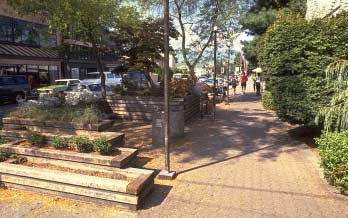
Landscaping can be used to channel and organize the traffic flow in parking
lots, as well as provide pedestrian refuge areas.
The location of commuter bus stops, particularly "flyer" park-and-ride stops, should be marked, as well as any difficult pedestrian/bicycle access problems, such as busy streets to cross or walk along. Opportunities such as short cuts that make access easier should be noted as well. The planner should try to envision how pedestrian/bicycle routes could connect bus stops to residential developments in the community. Since the success of suburban transit depends partly on the adequacy of sidewalks and the ease with which people can walk to bus stops, it is essential that safe sidewalks, separated from traffic, lead to each bus stop from nearby developments.
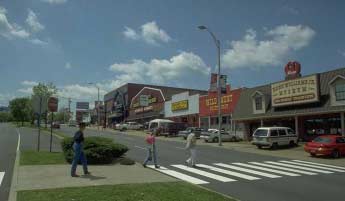
Medians and crosswalks should be placed at destination locations such
as this shopping center.
Walkways that are to be sufficiently safe, convenient, secure, and cause the least nuisance to residents must:
Entrances to many commercial and retail centers are oriented toward automobile travel. Bicycle and pedestrian access to storefronts is not only difficult and awkward, but often unsafe. For the purpose of this discussion, a shopping center is used as an example of how to retrofit existing developments to accommodate pedestrians. The same principles apply to other types of developments, such as office complexes and multi-family housing.
An average shopping center or "strip mall" is separated from the roadway by a wide parking lot that averages between 90 to 150 meters (300 to 500 feet) in depth. There are often no pathways linking store entrances to the sidewalks along the street, and sometimes there are no sidewalks on the street to be linked. Parking lots with multiple entryways allow traffic to circulate in different directions, creating hazards and confusion for walkers and cyclists. Drive-throughs at banks and fast-food restaurants in out-parcel developments add to pedestrian safety problems and encourage people to drive between different destinations on the site.
Storefronts do little to encourage walking. They are often barren and devoid of windows, and are therefore visually unappealing to a pedestrian. If they exist, walkways between stores are often narrow and uncovered, and pedestrian amenities such as benches are rare. Pedestrian connections between developments are not provided, encouraging shoppers to get back in their automobiles to access adjacent developments.
Although the problems with shopping centers are numerous, they can be redeveloped to better serve pedestrians. As older shopping centers undergo renovations, they should be redesigned to serve customers who arrive via transit, automobile, bicycle, and on foot. Specific methods include:
Describe 10 to 15 ways in which you would propose to retrofit a nearby residential development (or one that you grew up in) to make bicycling and walking viable forms of transportation. Elaborate on each idea, explaining how it would work and why it would improve the livability of the community.
Text and graphics for this lesson were derived from the following sources:
Oregon Chapter of the American Planning Association, Oregon Transportation Rule: Recommendations for Pedestrian, Bicycle and Transit-Friendly Ordinances, 1993.
Pennsylvania Department of Transportation, Pennsylvania Statewide Bicycle and Pedestrian Plan: Pedestrian Planning Guidelines, 1996.
Richard K. Untermann, Accommodating the Pedestrian, Van Nostrand Reinhold Company, Inc., New York, 1984.
For more information on this topic, please refer to:
Florida Department of Transportation, Florida Pedestrian Planning Guidelines, 1995.
Traffic Engineering Council Committee TENC-5A-5, Institute of Transportation Engineers, Design and Safety of Pedestrian Facilities-A Recommended Practice of ITE, 1998.
| < Previous | Table of Content | Next > |
